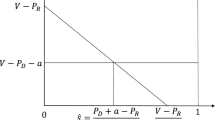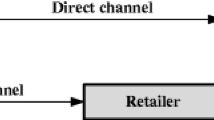Abstract
Retailers can make marketing efforts to increase the market demand, but the results from their activities are generally uncertain and influenced by free riding. This paper considers marketing strategies in a two-echelon supply chain under free riding, where a manufacturer sells products through two competitive retailers who have different powers. The dominant retailer will decide whether to make marketing efforts, and the following retailer will choose whether to follow the decision of the dominant retailer. We establish our demand functions relying on the price and marketing efforts, and then build six decentralized game models to examine how marketing strategies and power structures (manufacturer-dominant and retailer-dominant) affect supply chain members’ performances. It is found that, for the dominant retailer, he will make marketing efforts if free riding is not severe. As for the following retailer, in retailer-dominant structure, he will also make marketing efforts if the dominant retailer makes that, while his strategy varies with the degree of free riding in manufacturer-dominant structure. We also show that if the dominant retailer wants to make marketing efforts, he will make the same level of marketing efforts regardless of his market base and competitor’s decision.


Similar content being viewed by others
References
Balakrishnan A, Sundaresan S, Zhang B (2014) Browse-and-switch: retail-online competition under value uncertainty. Prod Oper Manag 23(7):1129–1145
Carlton DW, Chevalier JA (2001) Free riding and sales strategies for the internet. J Ind Econ 49(4):441–461
Chen X, Wang X, Jiang X (2016) The impact of power structure on the retail service supply chain with an O2O mixed channel. J Oper Res Soc 67(2):294–301
Chiu HC, Hsieh YC, Roan J, Tseng KJ, Hsieh JK (2011) The challenge for multichannel services: cross-channel free-riding behavior. Electron Commer Res Appl 10(2):268–277
Dan B, Liu C, Xu G, Zhang X (2014) Pareto improvement strategy for service-based free-riding in a dual-channel supply chain. Asia-Pac J Oper Res 31(06):1450050
Dogu E, Albayrak YE (2018) Criteria evaluation for pricing decisions in strategic marketing management using an intuitionistic cognitive map approach. Soft Comput 22(15):4989–5005
Esmaeili M, Abad PL, Aryanezhad MB (2009) Seller-buyer relationship when end demand is sensitive to price and promotion. Asia-Pac J Oper Res 26(05):605–621
Gurnani H, Erkoc M, Luo Y (2007) Impact of product pricing and timing of investment decisions on supply chain co-opetition. Eur J Oper Res 180(1):228–248
Giri B, Sharma S (2014) Manufacturer’s pricing strategy in a two-level supply chain with competing retailers and advertising cost dependent demand. Econ Model 38:102–111
Gurnani H, Xu Y (2006) Resale price maintenance contracts with retailer sales effort: effect of flexibility and competition. Nav Res Logist 53(5):448–463
He R, Xiong Y, Lin Z (2016) Carbon emissions in a dual channel closed loop supply chain: the impact of consumer free riding behavior. J Clean Prod 134:384–394
Heitz-Spahn S (2013) Cross-channel free-riding consumer behavior in a multichannel environment: an investigation of shopping motives, sociodemographics and product categories. J Retail Consum Serv 20(6):570–578
Huang H, Ke H (2017) Pricing decision problem for substitutable products based on uncertainty theory. J Intell Manuf 28(3):503–514
Huang H, Ke H, Wang L (2016) Equilibrium analysis of pricing competition and cooperation in supply chain with one common manufacturer and duopoly retailers. Int J Prod Econ 178:12–21
Huang Z, Nie J, Zhang J (2018) Dynamic cooperative promotion models with competing retailers and negative promotional effects on brand image. Comput Ind Eng 118:291–308
Ingene CA, Parry ME (1995a) Channel coordination when retailers compete. Mark Sci 14(4):360–377
Ingene CA, Parry ME (1995b) Coordination and manufacturer profit maximization: the multiple retailer channel. J Retail 71(2):129–151
Ke H, Wu Y, Huang H (2018a) Competitive pricing and remanufacturing problem in an uncertain closed-loop supply chain with risk-sensitive retailers. Asia-Pac J Oper Res 35(01):1850003
Ke H, Wu Y, Huang H, Chen Z (2018b) Optimal pricing decisions for a closed-loop supply chain with retail competition under fuzziness. J Oper Res Soc 69(9):1468–1482
Kuksov D, Lin Y (2010) Information provision in a vertically differentiated competitive marketplace. Mark Sci 29(1):122–138
Lei Y, Tang R, Chen K (2017) Call, put and bidirectional option contracts in agricultural supply chains with sales effort. Appl Math Model 47:1–16
Li H, Wang C, Shang M, Ou W, Qin X (2019) Cooperative decision in a closed-loop supply chain considering carbon emission reduction and low-carbon promotion. Environ Prog Sustain Energy 38(1):143–153
Lou W, Ma J (2018) Complexity of sales effort and carbon emission reduction effort in a two-parallel household appliance supply chain model. Appl Math Model 64:398–425
Ma P, Wang H, Shang J (2013) Supply chain channel strategies with quality and marketing effort-dependent demand. Int J Prod Econ 144(2):572–581
Pu X, Gong L, Han X (2017) Consumer free riding: coordinating sales effort in a dual-channel supply chain. Electron Commer Res Appl 22:1–12
Rokkan AI, Buvik A (2003) Inter-firm cooperation and the problem of free riding behavior: an empirical study of voluntary retail chains. J Purch Supply Manag 9(5–6):247–256
Shin J (2007) How does free riding on customer service affect competition? Mark Sci 26(4):488–503
Wang Y, Tang W, Zhao R (2018) Information sharing and information concealment in the presence of a dominant retailer. Comput Ind Eng 121:36–50
Wang Y, Tang W, Zhao R (2019) Supplier’s strategy: align with the dominant entrant retailer or the vulnerable incumbent retailer? Soft Comput 23(10):3481–3500
Wu D, Ray G, Geng X, Whinston A (2004) Implications of reduced search cost and free riding in e-commerce. Mark Sci 23(2):255–262
Xing D, Liu T (2012) Sales effort free riding and coordination with price match and channel rebate. Eur J Oper Res 219(2):264–271
Yang S, Ding P, Wang G, Wu X (2019) Green investment in a supply chain based on price and quality competition. Soft Comput 24(4):2589–2608. https://doi.org/10.1007/s00500-019-03777-y
Yang S, Munson CL, Chen B, Shi C (2015) Coordinating contracts for supply chains that market with mail-in rebates and retailer promotions. J Oper Res Soc 66(12):2025–2036
Zhao J, Tang W, Wei J (2012) Pricing decision for substitutable products with retail competition in a fuzzy environment. Int J Prod Econ 135(1):144–153
Zhou YW, Guo J, Zhou W (2018) Pricing/service strategies for a dual-channel supply chain with free riding and service-cost sharing. Int J Prod Econ 196:198–210
Acknowledgements
This work was partly supported by the National Natural Science Foundation of China (NO. 41971252) and the Fundamental Research Funds for the Central Universities.
Author information
Authors and Affiliations
Corresponding author
Ethics declarations
Conflict of interest
The authors declare that they have no conflict of interest.
Additional information
Communicated by V. Loia.
Publisher's Note
Springer Nature remains neutral with regard to jurisdictional claims in published maps and institutional affiliations.
Appendix
Appendix
Proof of Proposition 2
Referring to Tables 2 and 3, it can be easily obtained that if the two retailers both make marketing efforts, we have
If \(\frac{3}{8}<\lambda \le \), then we have \(\pi _1^{\mathrm{MS}\text {-}{1}}>\pi _1^{\mathrm{RS}\text {-}{1}}\), \(\pi _2^{\mathrm{MS}\text {-}{1}}>\pi _2^{\mathrm{RS}\text {-}{1}}\).
If only the dominant retailer makes marketing efforts, we have
If \(0\le \lambda <\frac{1}{4}\), then we have
Therefore, Proposition 2 is proved.
Proof of Proposition 4
From Table 2, we can find that
If \(\frac{1}{4}<\lambda \le 1\), then we have
We also find that
If \(0\le \lambda <\frac{1}{2}\), then we have
Thus, Proposition 4 is proved.
Proof of Proposition 5
Referring to Tables 2 and 3, we have
We can also get that
If \(0\le \lambda <\frac{3}{4}\), then we have
Thus, Proposition 5 is proved.
Proof of Proposition 6
Referring to Table 3, we get
If \(\frac{1}{4}<\lambda <\frac{3}{4}\), then we have
Besides, we have
If \(0\le \lambda <\frac{3}{4}\), then we have
Thus, Proposition 6 is proved.
Rights and permissions
About this article
Cite this article
Ke, H., Jiang, Y. Equilibrium analysis of marketing strategies in supply chain with marketing efforts induced demand considering free riding. Soft Comput 25, 2103–2114 (2021). https://doi.org/10.1007/s00500-020-05281-0
Published:
Issue Date:
DOI: https://doi.org/10.1007/s00500-020-05281-0




